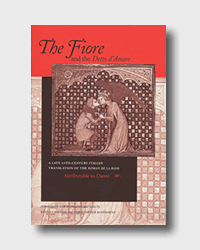|
characters who engage in various social (and bellic) interactions. There are personifications of social stereotypes and attitudes, mythological figures, abstract qualities, psychological and physical states, and personality traits.
The Detto d'Amore includes features of the perennial controversy between proponents of the pleasures of erotic passion and those who counsel pursuit of the sublime joys found solely in the exercise of reason. The incomplete poem also contains a conventionalized — and idealized — description of the physical traits of the lady, as well as a portrait of the perfect courtly lover.
The importance of these two works lies in part in their possible attribution to Dante. But even if Dante is not the author, the Fiore is a valuable witness to the literary taste and cultural concerns of medieval Italy and to matters of poetic influence and reception among different literary traditions.
This volume includes the full original text of both the Fiore and the Detto d'Amore together with facing page translations. It also includes three indexes: the Rubrics for the Fiore, the Characters and Places Mentioned in the Poems, and a General Index which includes references to footnotes.
Table of Contents
PREFACE
ACKNOWLEDGEMENTS
INTRODUCTION TO THE FIORE
The Fiore
INTRODUCTION TO THE DETTO D'AMORE
The Detto d'Amore
BIBLIOGRAPHY
THE RUBRICS OF THE FIORE
INDEX OF CHARACTERS AND PLACES MENTIOINED IN THE POEMS
GENERAL INDEX
SANTA CASCIANI is Director of the Bishop Anthony M. Pilla Program in Italian American Studies at John Carroll University in Cleveland and co-editor of Word, Image, Number: Communications in the Middle Ages.
CHRISTOPHER KLEINHENZ is Professor of Italian and Chair of the Medieval Studies Program at the University of Wisconsin-Madison. He is the editor of Dante Studies and co-editor of Saint Augustine the Bishop: A Book of Essays (1994), and Fearful Hope: Approaching the New Millenium (1999).
|




